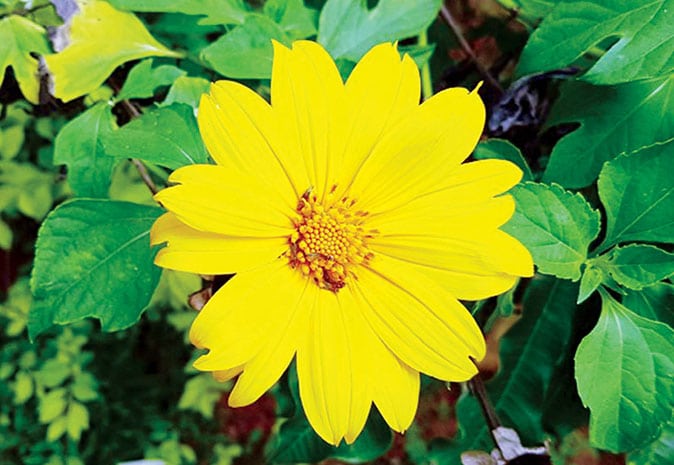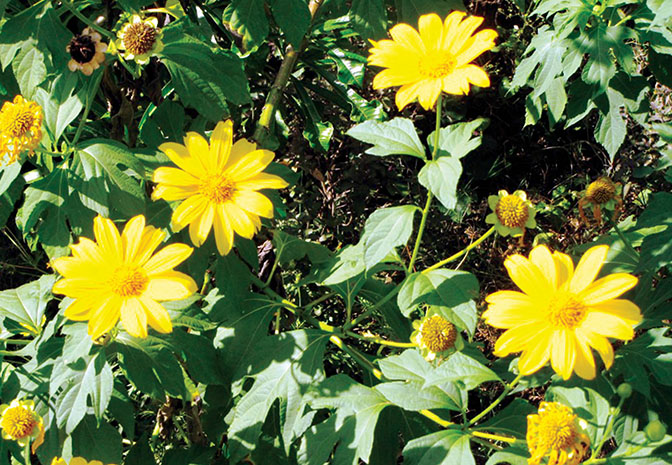Text & photographs by Dr. Mahadeswara Swamy Scientist
Tree sunflower is one of the most gorgeous flowering plants. The flower looks like a ‘Sunflower’ but does not turn in the direction of the Sun. It is a sibling of SUNFLOWER as both belong to the same family.
It is a fast-growing tropical shrub cultivated for its multipurpose value as a garden plant, for green manure production, as live fence besides a fodder crop for livestock. Its scientific name is Tithonia diversifolia (Synonym: Mirasolia diversifolia) of Asteraceae. Genus ‘Tithoni’ is named after Tithonus, the King of Troy, who was turned into a grasshopper by his lover Aurora; “diversifolia” refers to nature of the leaves. Other common names are ‘Giant Mexican sunflower’, ‘Japanese sunflower’, ‘Mexican Tournesol’, ‘Shrub Sunflower’, ‘Tree marigold’, ‘Kanak-gol’ (Hindi, Manipuri), ‘Kattu Suryakanthi’ (Tamil).
As there is no vernacular name I christened it as “MARA SURYAKANTHI.” Native to Mexico and Central America, it is naturalised in many tropical and sub tropical countries of South America, Africa, Asia, Australia and many islands across the Pacific and Indian Ocean. In India it is naturalised and found in Western and Eastern Ghats.

DESCRIPTION
Tithonia diversifolia is a robust perennial shrub growing up to 10 feet. The stems arise from the subterranean stolon. They are hollow, slightly ridged (striate) and hairy (pubescent) when young. Leaves borne on long stalks are alternate with a tapered base (cuneatee). Leaf blades are (lamina) broad (up to 10” x 8”) with 3-7 pointed lobes and serrate margins (toothed). They are puberulent (finely hairy (greyish-green). The flower-heads (capitula) on long stalks are borne at the end of mature branches. They are large and showy with bright yellow ray florets, look like petals, 7-15, each with three small teeth at their tips and a prominent central disc with innumerable tubular yellow flowers, called disc florets. These tiny flowers are surrounded by several rows of green bracts (involucre). One seeded fruits called achenes are dark brown and somewhat four-angled, topped with a ring of scales called pappus and two awns.

USES
Tree sunflower plant can be used for a variety of purposes like ornamental gardening, crop improvement, soil remediation, erosion control, fodder and fuel.
Planted as a living fence, it is useful in land demarcation along farm boundaries. Due to its rapid growth, the vegetative matter production is very high resulting in abundant nutrient-rich (NPK) biomass. Hence, the plant makes a good candidate for composting / green manure, soil improvement and soil rejuvenation with a positive effect on crop yield.
Green biomass has been reported to be an effective source of nutrients for lowland rice in some parts of Asia; rice and maize crops in Africa and Brazil; high-value crops like Brassica sp., Kale, French beans, Tomatoes and Napier grass in Kenya. Furthermore, leaves, soft branches and flowers are used as fodder for ruminants and rabbits and plants as shelter for poultry.
MEDICINAL PROPERTIES
In several countries the leaves are used for curing many ailments. Infusion of leaves is used in the treatment of constipation, stomach pains, indigestion, sore throat and liver pain; sometimes in the treatment of malaria as well. Leaf extracts are used externally for the treatment of wounds and haematomas. The leaves are reported to contain sesquiterpene lactones, including tagitinin as active ingredients and exhibit antimicrobial activity.
One study suggested its use in treating gastrointestinal infections, skin diseases and urinary tract infections. According to another report intake of this herbal preparations might lower the risk of human diseases such as atherosclerosis, inflammation, ageing, ischemic reperfusion injury and neuro-degenerative diseases.
Useful tips
- Very attractive shrub useful for big home gardens and farm houses.
- Plant them on either side of the pathway leading to main entrance and along the periphery.
- Grows in any type of soil and does not need any manurial application or maintenance.
- Flowers almost throughout the year.
- Requires bright sunny position for good flowering.
- The shrub expands fast by producing branches from the base (stolon). Trim the unwanted side branches and also remove the dried leaves for better show.
- The plant can be usefully planted in farm lands as live fence / on bunds; and leaves profitably used for manurial purposes.
- Composting: The vegetative parts can be decomposed for manure production along with other farm wastes.
- Green manure: Chop the tender parts (leaves and soft twigs) into small pieces and spread evenly on the ground before being incorporated into the soil for best results.
- Propagation: Plant can be easily propagated by direct sowing of seeds or stem cuttings (20-30 cm long). No special preparation of the soil is necessary.
- Leaf extract possess insecticidal properties and widely used by farmers in Uganda.
- The plant is invasive: produces abundant seeds, which are dispersed by wind, water and moving objects (livestock, humans and vehicles).
- Watch out and uproot them when young from unwanted / undesired places.
- Many birds, butterflies and insects visit the plant.
- Caution: Plant is not recommended for any type of forest development as it is invasive. Once established it quickly forms dense stands with a potential to out compete native vegetation. Thus prevent the establishment and growth of native plant species.
- In Indian context its usefulness as a herbal medicine need to be studied.
Tailpiece
The majestic shrub with upright stems with elegant green leaves and pretty yellow flowers on the top is a sight to behold and sure to brighten up your garden. A cynosure of all eyes, it is owner’s pride and neighbour’s envy !
Mob: 97429-91057 | e-mail: [email protected]








Recent Comments